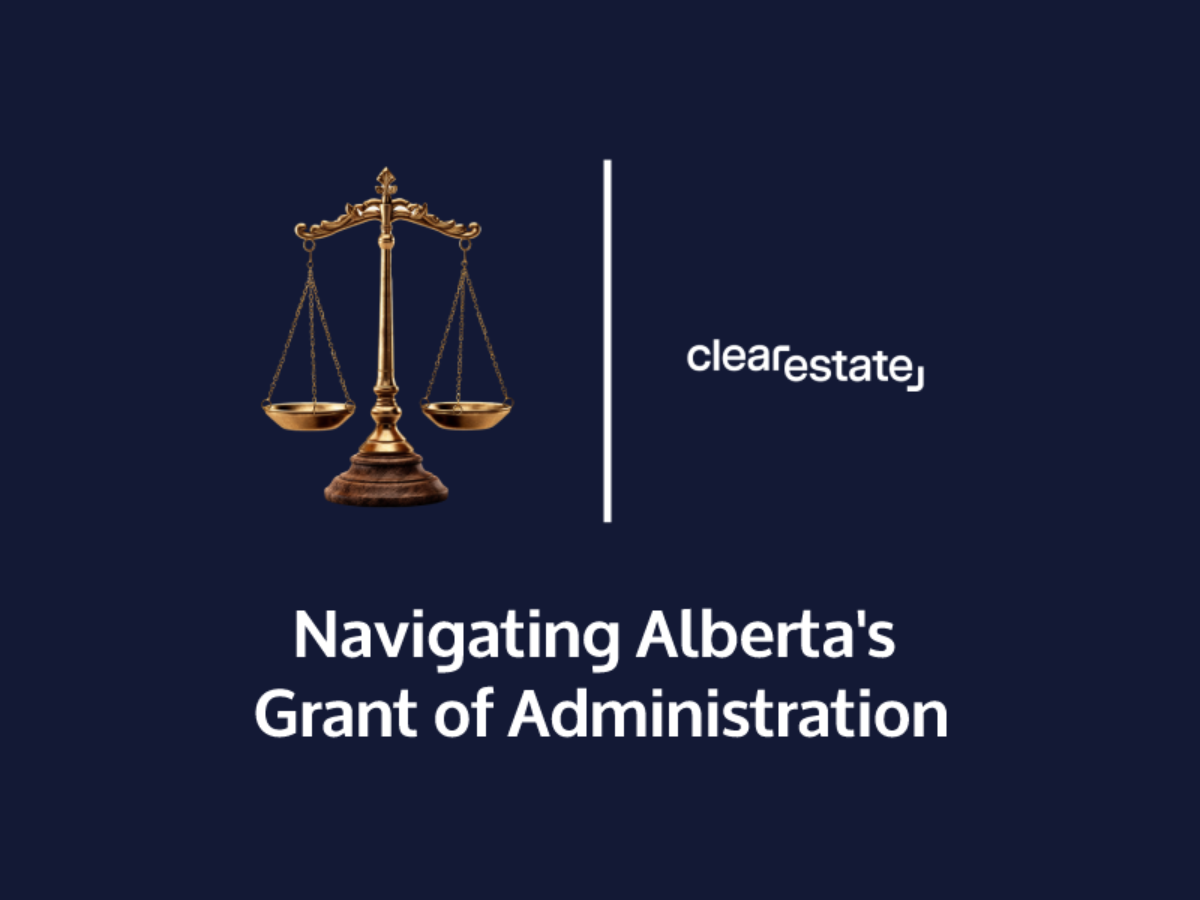Estate Settlement
Dec 04, 2024
How Do Executors Mail Inheritance Checks?
Find out how inheritance checks are mailed, including security measures and what to do if there are delays in receiving them.
Learn the steps involved in acquiring a Grant of Administration in Alberta and efficiently manage an estate with our expert guide.


A Grant of Administration is a document issued by the surrogate court, that empowers a person, referred to as the administrator or personal representative, to oversee and allocate the estate of a deceased individual who passed away without a legally recognized will (intestate).
Generally, the administrator is either the closest living relative or someone the court selects. The Grant of Administration bestows upon the administrator the legal capacity to accumulate the deceased's assets, settle any outstanding liabilities, and allocate the remaining assets in accordance with the intestacy laws.
It is important for the estate administrator to understand Estate Administration Act as it governs how estates should be managed and distributed. Estate assets, including real estate properties, need to be handled responsibly to ensure the beneficiaries, which may include children and other family members, receive their due share.
We understand how hard it is to probate an intestate estate in Alberta, to serve you better - we've created a table to help provide an overview of all the steps and estimated timeline involved with obtaining a grant of administration.
After the table, we dive deeper into each step - providing an in-depth guide with deeper insights into the forms to be filled, and best practices we've learned over the decades from administering estates in Alberta.
| Step No. | Action | Form (if applicable) | Description | Estimated Time |
|---|---|---|---|---|
| 1 | Acquire the Necessary Application Documents | Form GA1, GA2, GA3, GA5, GA7, GA16 | Visit the Alberta Courts website to download necessary forms. | 1-2 days |
| 2 | Assemble the Relevant Data | N/A | Compile details about the deceased, the beneficiaries, and the estate. | 2-4 weeks |
| 3 | Fill Out the Application for Grant Form | Form GA1 | Complete form GA1 with details regarding the deceased, the applicant, the beneficiaries, and the estate. | 1-3 hours |
| 4 | Complete the Estate Inventory Form | Form GA2 | Enumerate the estate’s assets and debts. Include comprehensive information on assets and liabilities. | 3-6 hours |
| 5 | Announce Notice to Debtors and Claimants | Form GA15 and GA16 | Publish a notice in a newspaper to inform potential creditors of the passing and allow them to file claims. | 2-3 weeks |
| 6 | Submit the Application | N/A | Lodge the application with the Surrogate Court. A filing fee will be applicable. | 1 day |
| 7 | Deliver Legally Mandated Notices | Form GA3 and GA4 | Send notifications to beneficiaries and certain other parties. | 2-3 days |
| 8 | Await the Court’s Response | N/A | Wait for the court’s evaluation. The court might request additional documents. | 6 weeks - few months |
| 9 | Distribute Notices Regarding Court’s Grant Approval | Form GA7 | Communicate the grant approval to all relevant parties. | 1-3 days |
| 10 | Execute Your Responsibilities | N/A | Administer the estate by settling debts, allocating assets, and finalizing the estate. | Varies |
Now that you’ve had a glimpse of the steps involved in obtaining a Grant of Administration in Alberta through the table, let’s delve into the particulars of each step.
This section aims to furnish you with a comprehensive understanding and practical guidance to successfully navigate through the process.
From gathering the essential documents to executing your responsibilities as an administrator, we’ll walk you through what’s involved, share helpful tips, and point out potential pitfalls to avoid. Whether you're unfamiliar with legal terminologies or uncertain about the specific requirements, this in-depth guide is designed to equip you with the knowledge and confidence needed in managing the estate of a loved one.
Acquire the Necessary Application Documents: Navigate to the Alberta Courts website for the essential documents you'll need to download. These are:
Fill Out the Application for Grant Form (GA1): Utilize this form to submit your application for the grant. It requests data regarding the deceased, the person applying, the beneficiaries, and the estate.
Complete the Estate Inventory Form (GA2): Use this document to enumerate the estate’s assets and debts. It is necessary to include comprehensive information on the deceased’s assets and liabilities, which includes legal descriptions of land, bank account details, financial institutions involved, pertinent interest rates, and accumulated interest since the time of death for bank accounts, investments, credit cards, loans, and so on.
Announce a Notice to Debtors and Claimants in a Newspaper (Form GA15 and GA16): This procedure serves to ensure that any prospective creditors are informed of the passing and are given the opportunity to file their claims.
** Ensure that notices are sent to all relevant parties. It's important to provide the address for service and contact information for parties involved.
Submit the Application to the Surrogate Court: After diligently completing all required documents and assembling all the necessary information, you can proceed to lodge the application with the Surrogate Court. A filing fee will be applicable.
Deliver Legally Mandated Notices (Form GA3 and GA4): It's obligatory to send notifications to every beneficiary and certain other parties involved using Form GA3. In cases involving a represented adult under the Public Trustee, a minor, or an individual whose whereabouts are unknown and who has an interest or potential interest in the estate, it is essential to notify the Public Trustee via Form GA4.
Anticipate the Court’s Response: Following the submission of your application, be prepared to await the court’s evaluation. The court might request supplementary documents or information.
Distribute Notices Regarding the Court’s Grant Approval (Form GA7): After the grant is approved by the court, it is necessary to communicate this to all parties who need to be informed by utilizing Form GA7.
Execute Your Responsibilities: Upon receipt of the grant, you may commence the administration of the estate. This entails settling any debts, allocating assets as per legal requirements, and finalizing the estate.
Navigating through the intricate steps involved in securing a Grant of Administration can be an overwhelming undertaking, especially when dealing with the loss of a loved one.
The probate process calls for an array of paperwork, adherence to rigid deadlines, and a thorough grasp of Alberta's Estate Administration Act - but it's not something that you need to go through alone.
At ClearEstate, we comprehend the nuances of estate management and we are dedicated to steering you effortlessly through each phase of the probate process. We offer a complimentary consultation during which we can explore your specific circumstances, address any queries you might have, and lay out the clear path to which we can facilitate your acquisition of a Grant of Administration.
Our professionals are wholeheartedly devoted to ensuring the estate in question is handled with utmost accountability and that the beneficiaries acquire what is rightfully theirs. Our support is extended to you in this trying period, to alleviate the strain you might be experiencing.
We encourage you to take the step to connect with us without delay and secure your free consultation. Let us be the compass guiding you through this labyrinthine procedure with tranquility and assurance. Bear in mind, this is not a burden you have to bear in by yourself.
Book your free consultation today.
Predominantly, immediate family members, such as a spouse, children, or other inheritors, hold the eligibility to file for a grant of administration. In certain instances, the involvement of the Public Trustee may be warranted, particularly if minor children or adult interdependent associates are involved.
To provide a ballpark figure, a grant of administration could be granted anywhere from 6 weeks to a few months. However, it’s imperative to note that this is a tentative timeframe and can be subject to fluctuation in the timeline.
During the waiting period, the estate administrator should ensure they are responsive to any legal notices and are prepared to provide additional information or documents as required by the court.
The fundamental distinction between a Grant of Administration and a Grant of Probate revolves around the presence or absence of a valid will at the time of the person’s death.
Grant of Probate: This is granted when an individual departs with a legally recognized will in place. The will generally specifies a Personal Representative (commonly referred to as an executor), who is vested with the responsibility to manage the estate in line with the directives laid out in the will. A Grant of Probate attests to the authenticity of the will and the legitimacy of the executor’s authority.
Grant of Administration: This is granted in instances where an individual dies intestate, meaning without a valid will. The court then assigns an administrator, typically a close family member, who is endowed with the responsibility to manage the estate according to the intestacy laws. A Grant of Administration ratifies the administrator’s authority.
In both scenarios, the designated individual istasked with the collection of the deceased's assets, settling any debts, and distributing the remaining assets. Nonetheless, in the case of a Grant of Probate, the allocation follows the instructions provided in the will, whereas with a Grant of Administration, the allocation abides by the laws of intestacy.
 Simplify Probate Today
Simplify Probate Today
Get expert guidance from our probate specialists who've helped 10,000+ families.
Book a free consultation today